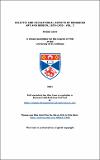Files in this item
Eclectic and neo-national aspects of Romanian art and design, 1878-1930
Item metadata
| dc.contributor.advisor | Howard, Jeremy | |
| dc.contributor.author | Lowe, Shona | |
| dc.coverage.spatial | 2 v. (354, 130) p. | en_US |
| dc.date.accessioned | 2015-08-21T11:36:13Z | |
| dc.date.available | 2015-08-21T11:36:13Z | |
| dc.date.issued | 2001 | |
| dc.identifier | uk.bl.ethos.654108 | |
| dc.identifier.uri | https://hdl.handle.net/10023/7299 | |
| dc.description.abstract | According to the words chiselled into its foundation stone in 1875, Castle Peles, the summer residence of King Carol I, was intended to represent the 'cradle' of the newly arrived Hohenzollern-Sigmaringen dynasty in Romania. Its construction coincided with the formation of the modern Romanian state and embodied a similar striving towards a convincing visual language of self-justification and definition. Initially employing international vocabularies, this language turned increasingly to possible 'national' sources of expression. This thesis examines the relationship between international influence and notions of a 'national style' in Romanian art at the turn of the twentieth century. It concentrates on a number of salient, but little studied factors in the search to define the multi-layered cultural identity of the newly formed kingdom. Firstly, it explores the artistic activity of the royal family. King Carol's 'transplanting' of weighty German tradition is contrasted with the British-born Crown Princess Marie's imaginative rejection of eclectic historicism and romantic reinvention of Arts and Crafts, Art Nouveau and 'primitive' sources. Artistic links with Vienna, Munich, Bohemia, Britain, Paris and Darmstadt, together with the significant contributions of individuals like the British designer Mackay Hugh BailIie Scott, the Czech architect Karel Liman and the Viennese Kiinstlerkompanie of Gustav and Ernst Klimt and Franz Matsch, are highlighted. Royal projects are examined against the backdrop of the emerging national style debate in the Romanian arts as a whole. Attempts to express Romanian identity in both the fine and applied arts are compared and evaluated. Particular attention is paid to the role of national and international exhibitions, together with the forum for artistic discussion provided by independent societies like Ileana and Artistic Youth. The thesis concludes with a comparison of public and private royal responses to neo- national ideas: firstly, in the grandiose monuments constructed for the Coronation of Ferdinand and Marie as King and Queen of Greater Romania in 1922 and, secondly, in the series of unusual country retreats created by Marie in the 1920s. | en_US |
| dc.language.iso | en | en_US |
| dc.publisher | University of St Andrews | |
| dc.subject.lcc | N7227.L7 | |
| dc.title | Eclectic and neo-national aspects of Romanian art and design, 1878-1930 | en_US |
| dc.type | Thesis | en_US |
| dc.type.qualificationlevel | Doctoral | en_US |
| dc.type.qualificationname | PhD Doctor of Philosophy | en_US |
| dc.publisher.institution | The University of St Andrews | en_US |
This item appears in the following Collection(s)
Items in the St Andrews Research Repository are protected by copyright, with all rights reserved, unless otherwise indicated.


